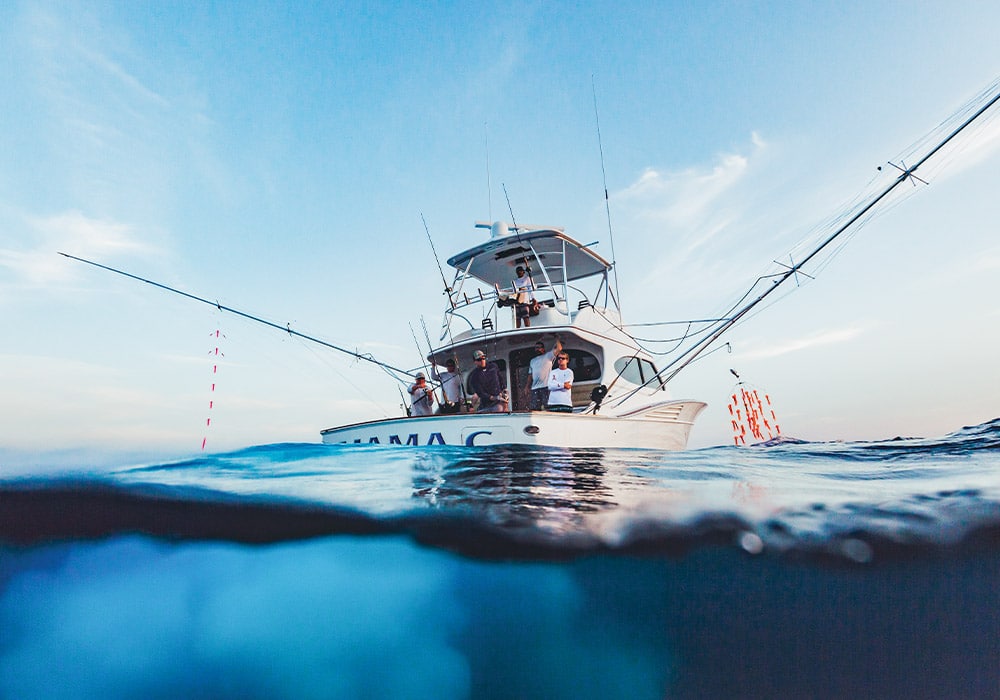
We were in the Hudson Canyon on a 35 Cabo in response to reports of a bigeye bite earlier in the week. The latest SST charts pinpointed our destination, so we were on the scene before first light, rigging baits, dropping the outriggers, and getting the cockpit ready for action.
At first light, line screamed off the 80s and we had a double hookup, a pair of nice bigeyes. One pulled the hook, but the second put on a knockdown, drag-out fight for over an hour. By the time the fish was in the boat, it was full daylight and a few other boats had joined us, including one of the Canyon Runner charter boats.
As the morning wore on, we caught a couple of small yellowfins, but Canyon Runner was making regular stops to fight larger fish. We changed the spread, tried more baits and different bars, switched out colors and bridge teasers, but nothing helped. They were catching and we were not. Back at the dock, I called the captain and discovered our problem: They were pulling dredges and we weren’t.
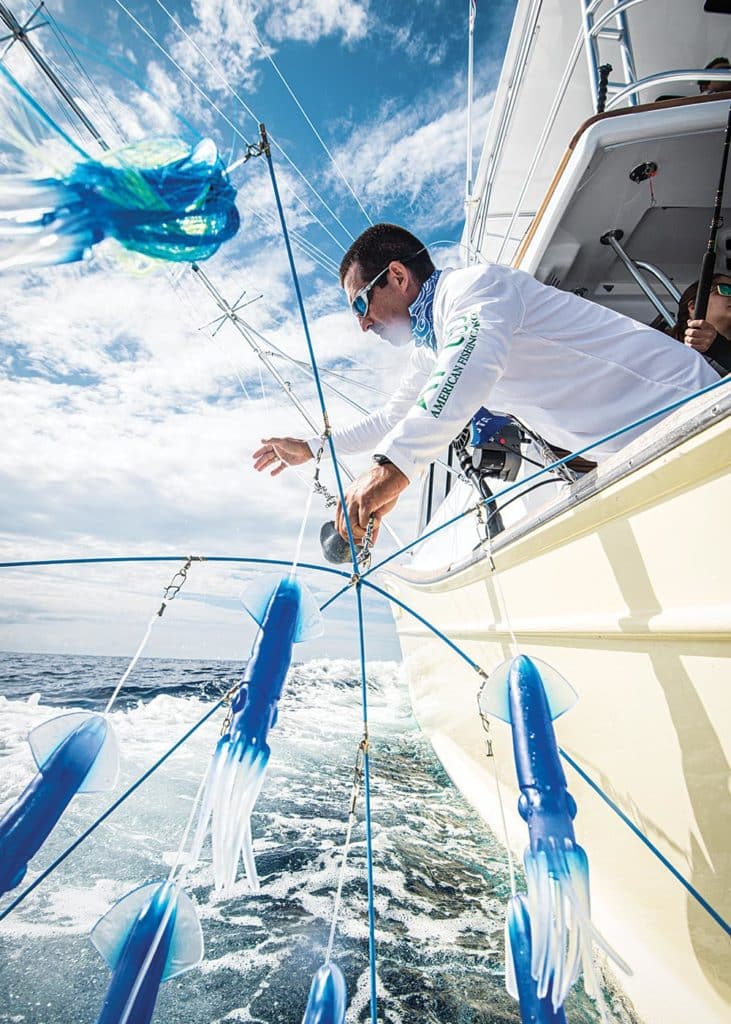
Deep Tease
A dredge is an oversize six-armed umbrella rig with leaders off each arm trailing a daisy chain of hookless plastic squids, lures or rigged natural baits that creates the illusion of a baitball below the surface. That’s what made the difference for Canyon Runner.
Our bridge teasers and spreader bars worked fine at first light when the tuna were near the surface, but as the day progressed, the fish moved deeper, and our presentation wasn’t visible enough to bring them up.
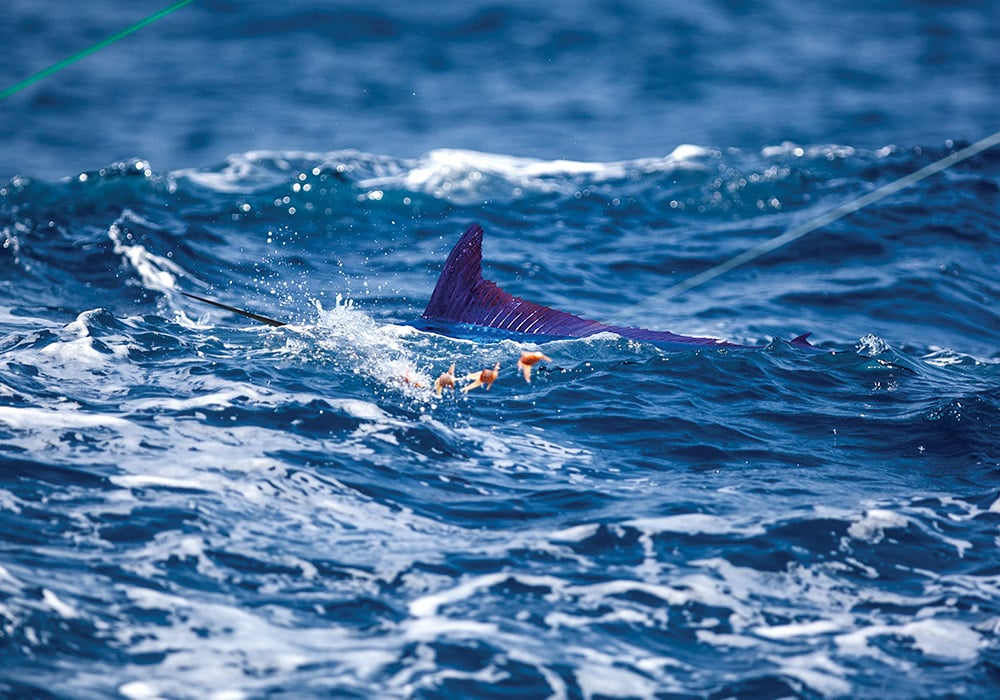
Dredges run 10 or 20 feet below the surface where they are easier for deep-holding predators to see, making it more likely that they’ll swim up into the commotion made by the rest of the spread. I’ve seen the effectiveness of dredges on white and blue marlin, sailfish, yellowfins, bigeyes, even bluefin tuna. I’ve seen white marlin holding 150 feet down rocket to the surface to inspect a dredge pulled just 15 feet down. I’ve also seen wolf packs of tuna holding even deeper rise to a dredge and attack the trolling spread above it when they wouldn’t budge for a full display of spreader bars and bridge teasers.
Once they are up inspecting the dredge, it’s a simple matter to entice them with one of the hook baits or toss them a pitch bait. Dredges encourage multiple bites as they raise and hold entire pods of gamefish.
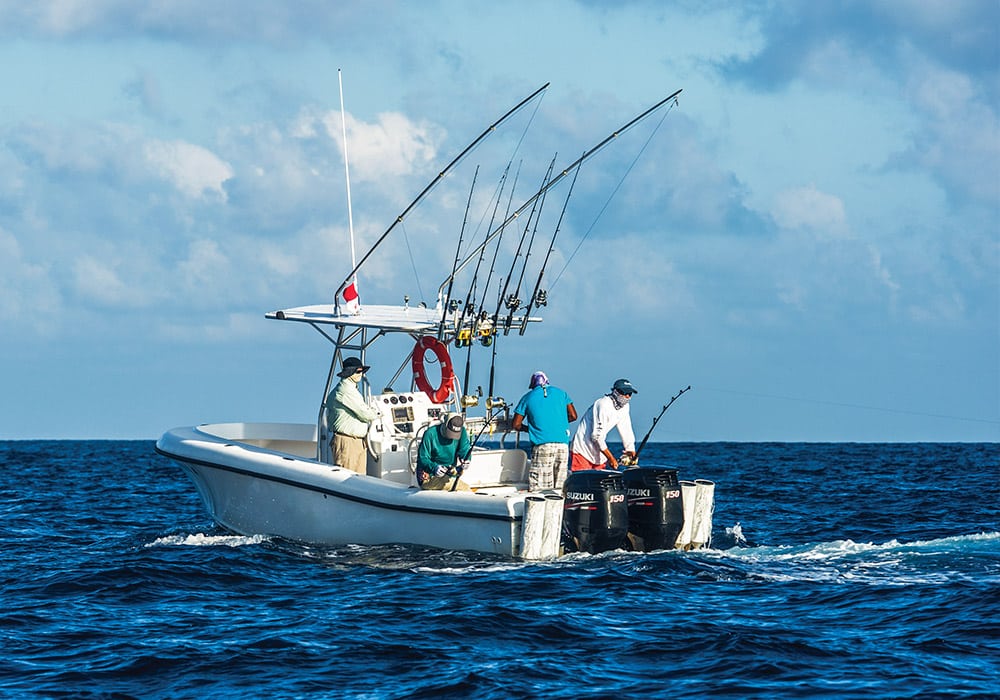
The Solution
Dredges, relatively easy to deploy from large boats with big outriggers and electric reels, require some modification on center-consoles with T-top-mounted riggers that just aren’t designed for that purpose. I’ve seen dredges pulled behind planers or hanging off a stern cleat, but both those methods make it tricky to adjust the dredge and get it out of the way after a hookup.
Last year I came across a method that solved the conundrum in the form of a downrigger on a swivel gimbal mount placed in a gunwale rod holder. I wasn’t the only one playing with the technique. Capt. Ricky Wheeler of Exile Sportfishing had come up with the same system when trying to set light-tackle records for Maureen Klause aboard her 27 Contender.
“It worked so smoothly that we ended up using it to set a number of records,” Wheeler says.
You can use a manual or electric downrigger with a 4-foot boom, which gets the dredge away from the boat like an outrigger, but it must be rigged to handle the weight and resistance of a dredge, and that requires a simple pulley system.
“We used a manual downrigger and pulled large dredges with 32 ounces of weight and rigged natural baits for Maureen’s record attempts,” Wheeler says. “She easily reeled them in with the single-pulley system.”
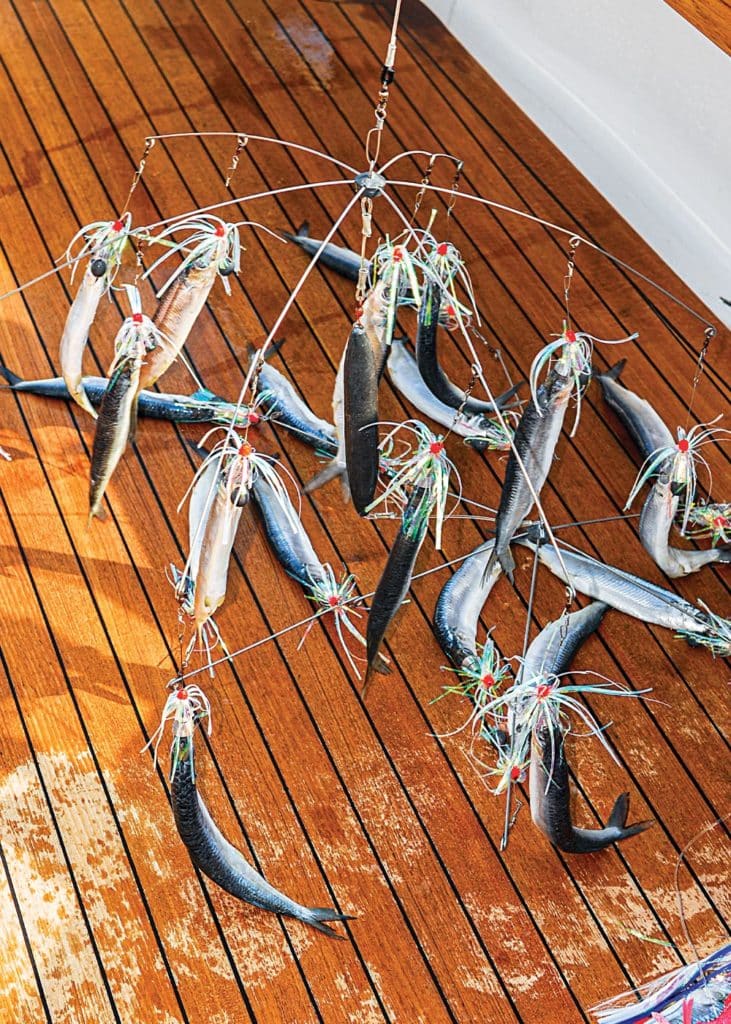
Dredge Selection
When picking a dredge, bigger is not necessarily better, so shy away from the huge 36-inch double and triple dredges used on big tournament boats. Bill Pino, owner of Squidnation, a supplier of dredges and teasers, offers models designed specifically for small boats. The most popular, the Compact Dredge, features a 24-inch six-arm front bar and a 12-inch four-arm second with one string of plastic squids, either seven or nine, off each arm.
He also explains how to weight the dredges.
“Some anglers put excessive weight on their dredges to keep them running subsurface close to the boat. I prefer to use less lead and run it a bit farther back from the outboards in cleaner water. It’s still effective, and you don’t necessarily have to see every fish coming after it for it to work,” he says. Another model, the Australian Small Boat Dredge designed for customers Down Under, is even more compact.
Chuck Richardson at Tournament Cable Tackle manufactures a line of Bucket Dredges, so named because they store in a 5-gallon bucket. They are armed with his proprietary 3D Stickbaits made from reflective acrylic that provides flash. They come in 8-inch ballyhoo or 9-inch mullet shapes, and offer less resistance in the water than plastic squids. Bucket Dredges include three, six-arm 10½-inch bars with 18 Stickbaits and come with the bucket.
“We have another more traditional bar that is popular with center-console guys,” Richardson says. “The EZ6 Collapsible has 30- and 24-inch six-arm spreaders in the double model or an additional 18-inch bar in triple.”
Read Next: Dredge Fishing Tips from Center Console Boats
The arms are mounted on a central shaft that allows them to be swiveled flat for storage in a large lure bag. He also offers an even simpler hand-line dredge called the Teaser Boom. It might work for you as long as you don’t mind deploying and pulling the dredge hand over hand.
There is no doubt that dredges attract more fish offshore; tournament anglers have known it for years. Outboard boats heading offshore get in on the benefits by using these simple rigging techniques. You’ll catch more tuna and billfish for sure.
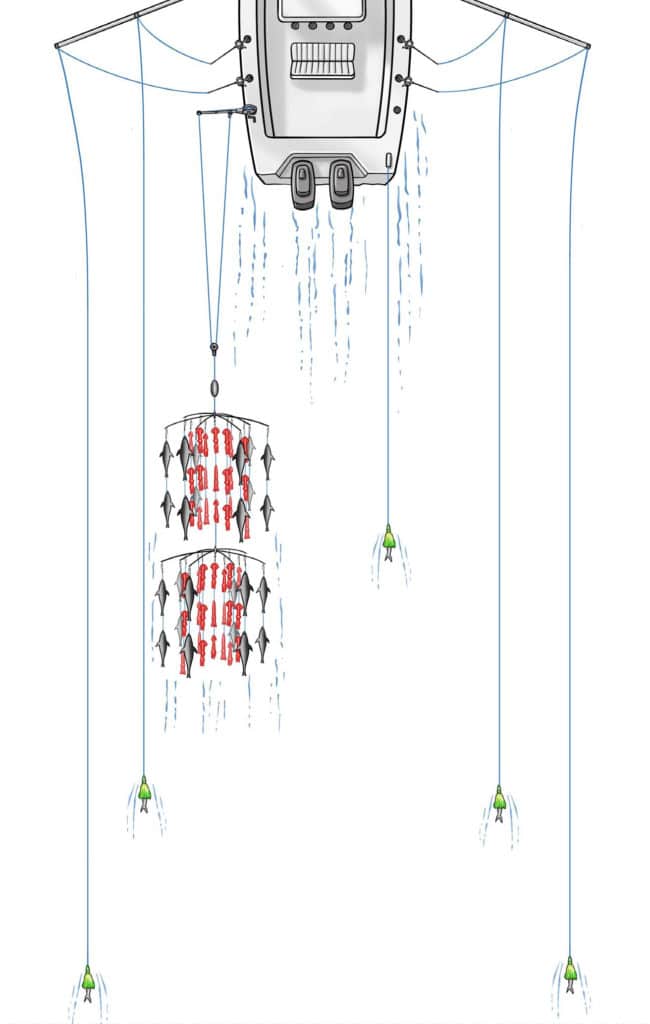
Safeguard the Downrigger
For most dredges deployed on smaller boats, a single-pulley and tag-line setup is the only downrigger modification required. For larger, heavier dredge configurations, care must be taken not to overstress the downrigger boom, swivel base or rod holder with the weight of the dredges and attending water pressure on the rig. For reinforcement and stability, run a length of paracord from the roller end of the downrigger boom to a spring-line cleat on the boat. By cleating off the reinforcement line, you can quickly adjust the line for the best support, and release it from the cleat to swivel the downrigger forward when fighting a fish.
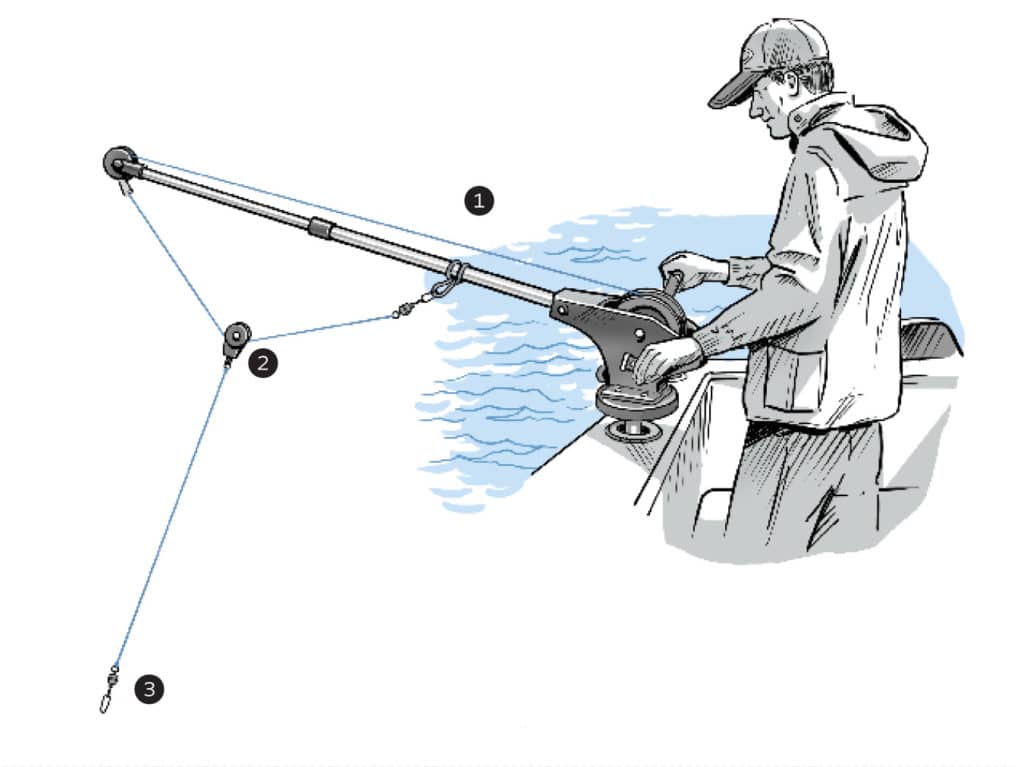
Pulley Mod for Downriggers
Load the downrigger with 300-pound mono and run the tag end through the boom roller. Make a 12-inch loop of parachute cord and girth-hitch it around the boom [1] about a third of the way between the spool and the roller. Then thread the downrigger line through a stainless-steel dredge pulley [2] and crimp on a 400-pound-test snap swivel. Snap this to the paracord loop girth-hitched to the boom to create a triangle from the boom tip to the pulley and back to the boom arm. Attach a length of heavy mono ending in a snap swivel to the eye of the pulley [3], to which you fasten the dredge. The mechanical advantage created by the pulley eases retrieval.









